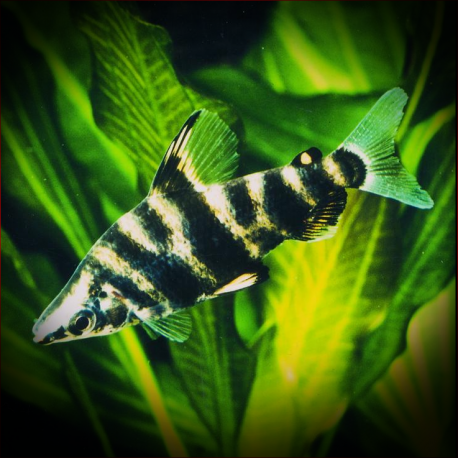More info
Datasheet
| Minimum Tank Size | 120 litres / 31.70 US gallons |
| Maximum Size | 14.0cm / 5.51inches |
| Temperature | 20°C / 68.00°F - 30°C / 86.00°F |
| Hardness | 1.01dgH / 18ppm - 15.02dgH / 268ppm |
| pH | 5.5-7.5 |
General Description
The Marbled Headstander, scientifically known as Abramites Hypselonotus, is categorized under the order Characiformes and belongs to the family Anostomidae. These fish are recognized by their relatively deeper bodies and the presence of a noticeable post-pelvic median keel, a distinctive feature exclusive to the genus. A. eques is the only other species recognized, native to the Río Magdalena drainage in western Colombia. They are described as opportunistic omnivores with a varied diet that includes benthic items like sponges, insect larvae, organic detritus, seeds, leaves, and filamentous algae.
Aquarium Setup
Ideally, Marbled Headstanders are best kept in a group within a large tank, alongside robust cichlids, characins, and catfish species. Although not critical, the tank setup should meet basic maintenance requirements. Soft-leaved plants can be at risk of being consumed by these fish. Water conditions should fall within a pH range of 5.5-7.5, a temperature range of 20-30°C, and a hardness of 18-268ppm.
Behaviour
With an inclination to nip at long or trailing fins, Marbled Headstanders exhibit an inclined feeding posture, a characteristic behavior that earned them the common name 'headstanders.' They are known to be adaptable in captive settings and will accept various high-quality prepared foods, live or frozen bloodworms, Daphnia, Artemia, among others.
Feeding and Diet
In their natural habitat, Marbled Headstanders are ecological generalists, inhabiting various habitat types ranging from main river channels with flowing water to minor tributaries and backwaters. They also venture into temporarily-inundated zones during annual floods. Their diet, in addition to prepared foods, often includes greenery like fresh algae, fruits, vegetables, or dried products rich in Spirulina.
Reproduction & Dimorphism
There are no documented instances of captive breeding for Marbled Headstanders. Sexually mature females are typically deeper-bodied compared to males. Within the Anostomidae family, these fish form a distinct clade most closely related to Leporinus, with unique dental characteristics of three to four teeth arranged in a step-like fashion in each premaxillary or dentary.
Habitat and Distribution
Originally described from 'Xeberos,' Peru, the Marbled Headstander has an extensive natural range encompassing the Amazon and Orinoco river basins in countries like Bolivia, Brazil, Colombia, Ecuador, Guyana, Peru, and Venezuela. They are also found in the Paraguay-Paraná system extending across southern Brazil, Paraguay, and Argentina.

